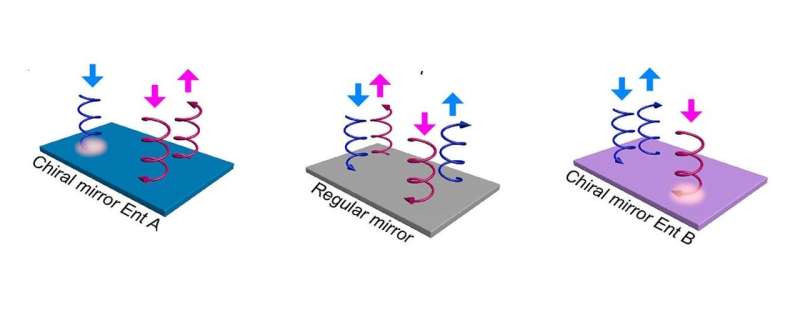November 14, 2017 feature
New mirror reflects light differently than conventional mirrors

(Phys.org)—Researchers have designed a new type of mirror that reflects light in a completely different way than conventional mirrors do. The new mirror, called a chiral meta-mirror, has potential applications for information processing with light, next-generation 3-D movies, and other technologies that manipulate light in novel ways.
The researchers, led by Wenshan Cai at the Georgia Institute of Technology, have published a paper on the chiral meta-mirror in a recent issue of Nano Letters.
The unconventional reflective properties of the new mirror arise from the way in which the mirror responds to light that is circularly polarized. Light waves are composed of electric and magnetic fields, and when the electric field travels slightly behind the magnetic field or vice versa, the light wave moves along a helical path through time, and this is called circularly polarized light. Most of the light around us, such as light from the sun and lightbulbs, is unpolarized but can become polarized by passing through a polarization filter.
A circularly polarized light wave can travel in either a clockwise (right) or counterclockwise (left) fashion, which is determined by an intrinsic physical property of light called the spin angular momentum and, consequently, is called the spin state of light. The main difference between the new mirror and conventional mirrors is how each responds to the spin states of circularly polarized light.
When a circularly polarized light beam reaches a conventional mirror, the mirror reverses the beam's spin state, so that the light it reflects back out has the opposite spin as the light that enters. For many applications, this property does not pose any problems, and in fact mirrors are one of the most important components of many optical devices. However, for certain new applications such as photonic information processing in which the spin states of light carry data, it is important to maintain and control the spin states when reflected by mirrors.
The new chiral meta-mirror does almost the opposite of a conventional mirror with respect to spin states. Instead of reflecting the opposite spin state, it reflects the same spin state of an incident circularly polarized beam, but only for one spin state. When a beam with the opposite spin state arrives at the mirror, the mirror completely absorbs that light. So the final result is that the mirror reflects only light with one spin state—either left or right circularly polarized beams, but not both.

"We offer the ability to preserve spin states of an optical wave upon reflection from a chiral meta-mirror," Cai told Phys.org. "In sharp contrast to a regular reflective surface, the chiral meta-mirror operates by absorbing one spin state, while allowing the other to be reflected back with the same spin state as that of the incident wave."
While most conventional mirrors are made of common metals, such as a thin silver film covered by a thicker piece of glass, no known natural material has the chiroptical property exhibited by the new mirror. For this reason, the researchers fabricated the new mirror from an artificial material—a metamaterial with a nanoscale geometry designed specifically to exhibit this property. The meta-mirror consists of a thin film perforated by an array of asymmetric holes, and this asymmetry contributes to the unconventional chiroptical response.
"Metamaterials, which offer light manipulation on the nanoscale, can achieve polarization alteration in propagation lengths of just a couple hundred nanometers," Cai said.
The researchers note that the chiral meta-mirror is relatively easy to fabricate, and they expect that it will have applications in optical data transmission and other technologies that they plan to further investigate in the future.
"Some of the most common ways to send data via optical means is by time-division or wavelength multiplexing," Cai said. "However, as the demand for increasing data bandwidths grows, a higher degree of multiplexing is needed. In terms of optical communications, polarization control opens another paradigm for multiplexing and data handling. The ability of our meta-mirror to preserve an incident spin state will aid in the development of these polarization-sensitive systems.
"Chiral meta-mirrors can also be used for applications in chiroptical sensing, chiral signal analysis, and may even play a part in the next generation of 3-D movies. Most 3-D movies rely on the left and right handedness of the circularly polarized light that passes through the glasses that we wear in the theaters. With this polarization distinction at hand, chiral meta-mirrors could even find utility in this industry."
More information: Lei Kang et al. "Preserving Spin States upon Reflection: Linear and Nonlinear Responses of a Chiral Meta-Mirror." Nano Letters. DOI: 10.1021/acs.nanolett.7b03882
Journal information: Nano Letters
© 2017 Phys.org



















